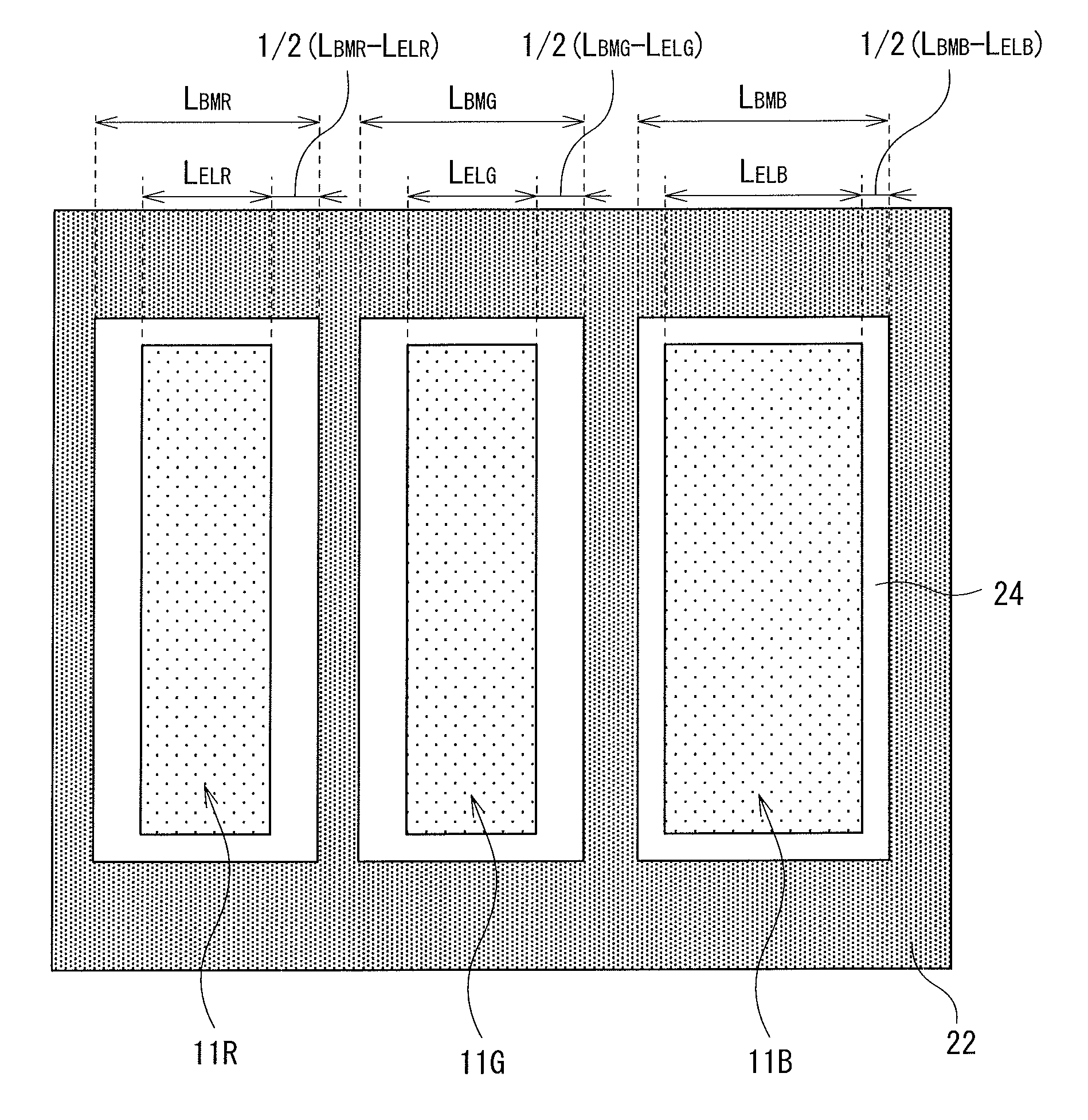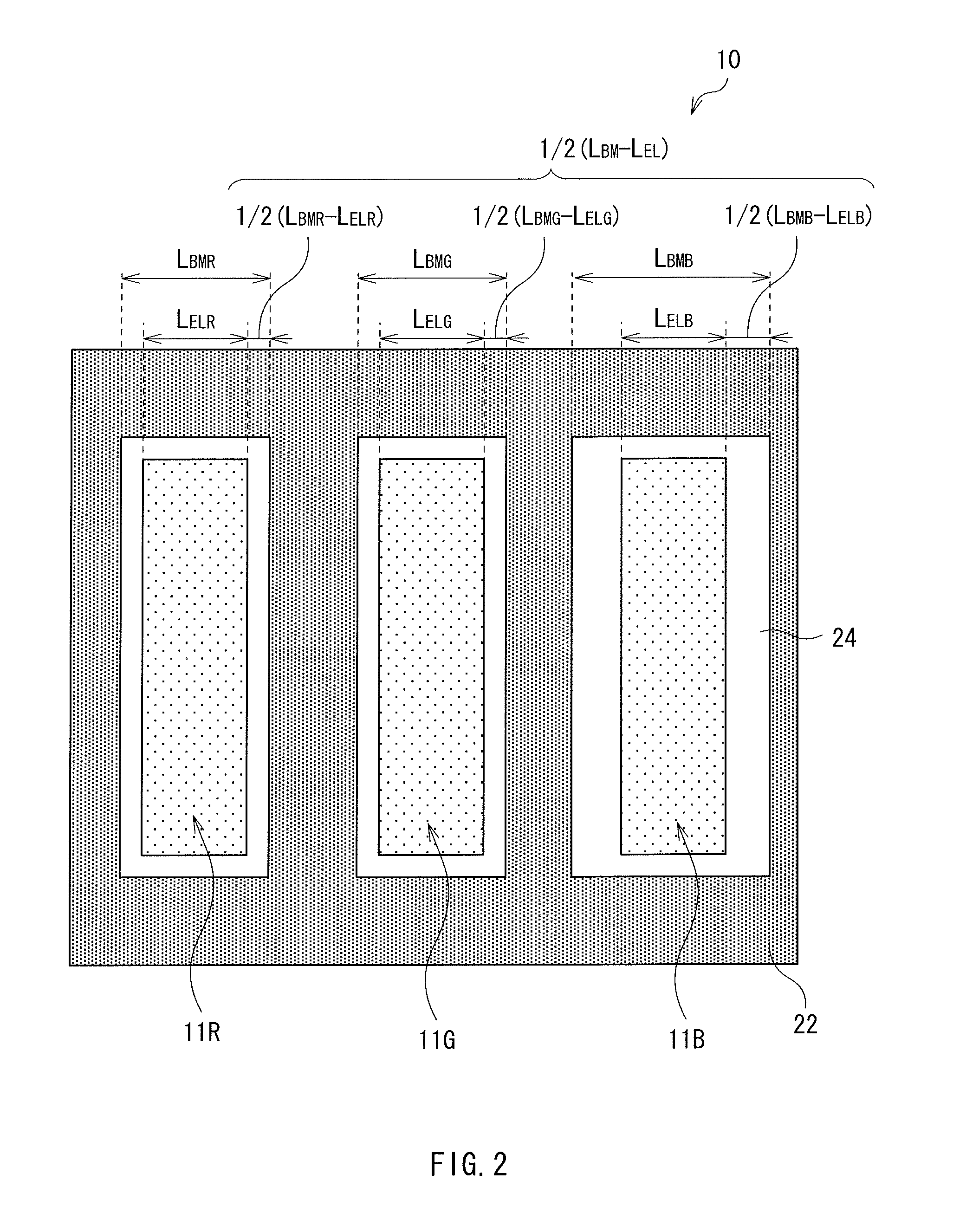Display device with clearance
a technology of display device and clearance, which is applied in the direction of solid-state device, spectral modifier, light and heating apparatus, etc., to achieve the effect of disrupting the luminance balance and improving the efficiency of light extraction
- Summary
- Abstract
- Description
- Claims
- Application Information
AI Technical Summary
Benefits of technology
Problems solved by technology
Method used
Image
Examples
embodiment
1. Embodiment
[0039](1) Description of the principle (example where width of emission regions are the same between all colors, and a blue clearance is large compared with that for another color)[0040](2) Calculation example 1 (example where width of emission regions are the same between all colors, and a blue clearance is small compared with that for another color)[0041](3) Calculation example 2 (example where width of a blue emission region is large compared with width of another color emission region, and a blue clearance is small compared with that for another color)
2. Modification 1 (Example where a Clearance is Continuously Changed within One Self-Luminous Element)
3. Application Examples
[0042]FIG. 1 shows an example of a planar configuration of a display device according to an embodiment. The display device 1 is used for a television apparatus or the like, and has a configuration where a plurality of pixels 10 are arranged, for example, in a matrix in a display region 110. Each ...
example 1
Calculation Example 1
[0064]FIGS. 4 and 5 show a planar configuration and a sectional configuration of a pixel 10 according to calculation example 1, respectively. In the calculation example 1, as shown in FIG. 4, while widths of the emission regions 11R, 11G and 11B are the same between all colors, width LBMB of the opening 24 facing the blue emission region 11B is smaller than widths LBMR and LBMG of the openings 24 facing the red and green emission regions 11R and 11G. Accordingly, the clearance, ½(LBMB−LELB), of the blue self-luminous element 10B is smaller than the clearances, ½(LBMR−LELR) and ½(LBMG−LELG), of the red and green self-luminous elements 10R and 10G. These are summarized in numerical expression 7.
Width of emission region: LELR=LELG=LELB=60 μm
Width of opening: LBMR=LBMG=76 μm,LBMB=70 μm
Red clearance: ½(LBMR−LELR)=8 μm
Green clearance: ½(LBMG−LELG)=8 μm
Blue clearance: ½(LBMB−LELB)=5 μm Numerical expression 7
[0065]FIG. 6 shows a calculation result of a chromaticity-to-...
example 2
Calculation Example 2
[0068]FIGS. 8 and 9 show a planar configuration and a sectional configuration of a pixel 10 according to calculation example 2. In the calculation example 2, as shown in FIG. 8, width LELB of the blue emission region 11B is larger than widths LLER and LLEG of the red and green emission regions 11R and 11G. In addition, width LBMB of the opening 24 facing the blue emission region 11B is larger than widths LBMR and LBMG of the openings 24 facing the red and green emission regions 11R and 11G. Accordingly, the clearance, ½(LBMB−LELB), of the blue self-luminous element 10B is smaller than the clearances, ½(LBMR−LELR) and ½(LBMG−LELG), of the red and green self-luminous elements 10R and 10G. These are summarized in numerical expression 8.
Width of emission region: LELR=LELG=50 μm,LELB=74 μm
Width of opening: LBMR=LBMG=66 μm,LBMB=84 μm
Red clearance: ½(LBMR−LELR)=8 μm
Green clearance: ½(LBMG−LELG)=8 μm
Blue clearance: ½(LBMB−LELB)=5 μm Numerical expression 8
[0069]The reas...
PUM
 Login to View More
Login to View More Abstract
Description
Claims
Application Information
 Login to View More
Login to View More - R&D
- Intellectual Property
- Life Sciences
- Materials
- Tech Scout
- Unparalleled Data Quality
- Higher Quality Content
- 60% Fewer Hallucinations
Browse by: Latest US Patents, China's latest patents, Technical Efficacy Thesaurus, Application Domain, Technology Topic, Popular Technical Reports.
© 2025 PatSnap. All rights reserved.Legal|Privacy policy|Modern Slavery Act Transparency Statement|Sitemap|About US| Contact US: help@patsnap.com



